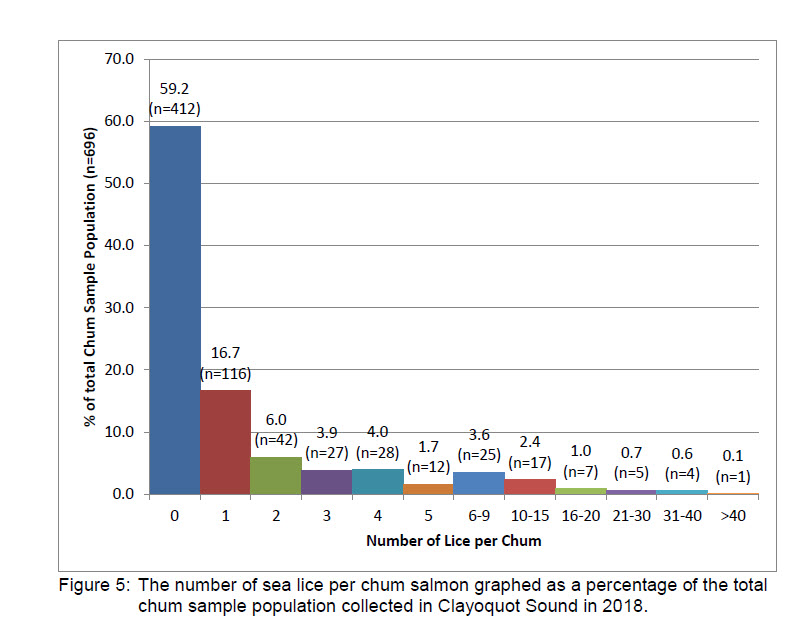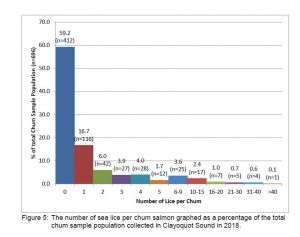Wild about salmon: One of the vocal anti-salmon critics tweeted this week ‘What will it take to get one salmon to return to a west coast river ravaged to extinction by fish farms?’ This was in response to a tweet about the International Year of the Salmon which was accompanied by a photo of the Scottish Environment Secretary standing on the banks of a river with an angler complete with rod and hook. NASCO say that the reason for having an International Year of the Salmon is because of their biological and economic importance. This is of such importance to NASCO that they have repeated this explanation twice on their website. To us it seems that the message is not about protecting and conserving wild salmon but rather how their viability for exploitation can be maintained. It would appear that keeping the salmon angler happy is the primary aim of this year long event.
One thing that the anglers are not happy about is salmon farming. Although wild fish are in decline across their whole range, salmon farming is seen as the main issue. We are currently waiting for the Scottish Parliament’s Rural Economy Committee to issue their report about salmon farming however before the report is issued, it is worth remembering that their enquiry was promoted by the Petition PE01598 which was submitted a couple of years ago by Salmon & Trout Conservation Scotland. The petition title was protecting wild salmonids from sea lice from Scottish salmon farms and urged the Scottish Government to strengthen legislation affecting marine farms to protect wild salmon of domestic and international conservation importance.
Unfortunately, Salmon & Trout Conservation were unable to provide any real evidence that salmon farms are actually impacting on wild fish populations. Instead, the basis of their claims rest on the conservation status of rivers within the ‘aquaculture zone’. The petition reads:
Wild salmonids in the ‘aquaculture zone’ on the west coast are in trouble. in 2015, the Scottish Government published the latest classification of the country’s salmon rivers’ salmon populations, placing all rivers in the west Highlands and inner Hebrides including river systems such as the Awe and the Lochy, in the worst performing category, with wild salmon stocks not reaching their conservation limits (a measure of the overall health of the population) No river within salmon farming’s heartland of west Highlands and inner Hebrides has, in Scottish Government’s estimation, a sufficient stocks of wild salmon to support any exploitation
They also referred to a scientific paper that suggests that there is an impact, but this paper is one of several that are highly contentious and apply to the wider salmon industry rather than what happens on the west coast.
The conservation categories for west coast rivers as set in 2015 reflect the first attempt to establish the conservation status of Scottish rivers. For may rivers not all the required information was immediately available and hence the Scottish Government took a precautionary approach and placed all west coast rivers in category 3 which means that they could not be exploited so anglers were subject to mandatory catch and release. Since 2015, more and more information has been applied to the data already available. This means that the conservation status for each river has steadily evolved.
For 2019, the conservation status of 99 west coast rivers and fishery districts has been established as:
Category 1 – 17%
Category 2 – 19%
Category 3 – 64%
This means that 36% of rivers and fishery districts in the west coast ‘aquaculture zone’ can now be exploited. Clearly, this is a major improvement on the conservation status for these rivers that was fixed in 2015. The changing status of these rivers demonstrates that the claims made by Salmon & Trout Conservation are not proven. As we repeatedly maintain, the evidence is simply circumstantial.
This is something that the REC Committee should consider before they issue their report. There are many other reasons why wild fish stocks could have declined but there seems to be no focus on these. It is all about salmon farming.
It is worth remembering that the change to category 1 and 2 rivers means that the west coast rivers which are supposedly near extinction can now be exploited; the polite way of saying that anglers kill the fish they catch. Surely, if west coast rivers are in such a dire state, the first thing to stop is killing fish for sport. Unfortunately, whilst S&TC continue their campaign against salmon farming, they have yet to demand a stop to killing all wild fish for sport. We thought the point of conservation as appears in S&TC’s name is to conserve and protect but we think their underlying message is to conserve and protect salmon from others, so anglers can catch and kill them.
Interactions: Fishupdate has reported that the first meeting of the farmed and wild salmon interactions group took place recently in Edinburgh. According to the Chairman, John Goodlad, it was an excellent meeting.
John Goodlad said that there was an agreement that deliberations must be transparent with minutes posted on a website. We therefore wait to see these minutes before making any comment.
What we found of interest was the response of the anti-salmon farming lobby to this meeting, especially on Twitter.
One tweet reads ‘The Salmon Interactions Working Group met today – loaded up with aquaculture people who will continue towards the cliff whatever happens. The group will get absolutely no-where with anything. All it will do is go round in circles.’
Fishupdate reported on the make- up of the group. The group includes two representatives from the SSPO; two from Fisheries Management Scotland representing wild fish interests and representatives from Scottish Natural Heritage, SEPA, Marine Scotland and Scottish Environment Link. Whichever way we crunch the numbers, the simple fact is that the salmon farming industry is in a minority. The reality is that this tweet is typical of much of the nonsense about salmon farming posted on Twitter; it is just factually wrong.
The SSPO posted a comment about the meeting on their website saying that they hoped for a more productive working relationship between the two sectors and both deserve to be supported. The response from the tweeters was ‘Yet more lies and deceit from the SSPO. If you believe this, you believe anything.’
This is the real problem. It is impossible to have a rational debate because there are some who simply won’t listen. They have a view and simply stick to it whether the facts support them or not.
One example of the divide between what is being claimed and what is fact comes from Salmon & Trout Conservation. They claim that wild fish populations are in decline due to the impact of sea lice emanating from salmon farms. Their website provides links to many documents and press releases but not one of them can provide proof that wild fish have declined due to salmon faring. All the evidence is circumstantial
Their latest press release comments on the fact that the salmon farming industry has suggested that wild fish are implicated in the spread of sea lice. This does not mean that wild fish and salmon farming cannot co-exist in harmony because they not only can, but they already do. S&TC say that this focus on the wild fish is simply a way of deflecting attention away from the salmon industry’s problems. They should know. They are experts as this is exactly their strategy. Their latest postings, for example, are focused on salmon farming and make no mention of wild fish at all. This is because they do not have the evidence to support their claims, so it is simply easier to deflect attention onto the salmon farming industry.
Salmon & Trout Conservation are not alone in this approach. The Vancouver Sun recently reported that sea lice are out of control on the BC coast. This comes from a report issued by Living Oceans and Raincoast Research aka Alexandra Morton. The paper quotes the report, Lousy Choices, stating that’ this year sea lice are responsible for “considerable losses” to wild salmon in Clayoquot Sound’.
Although the report is 23 pages long, there is nothing to back up this claim of considerable losses, simply an assumption based on a survey that found 96% of juvenile wild salmon in the area were infected with an average of eight lice per fish with some carrying as many as 50 lice. One piece of research suggests that it only takes one to three lice to kill a young fish, therefore any juvenile salmon carrying lice as surveyed must have died.
What we found most interesting about the report is that as well as citing the lice levels found by a wild fish group, they also included the results of a survey commissioned by Cermaq, the local farming company. This was conducted by a local commercial survey company, Mainstream Biological Consulting.
The results published by Cermaq, are summarised in the following table. The main species caught was chum salmon and the report implies that this is because other species may have been wiped out. Equally, they may not have been caught. The report also says that the Cermaq results may not be as comprehensive as those carried out by others due to timing, method etc but the results of the other survey were not displayed in a similar way to those from Cermaq, which makes comparison difficult.
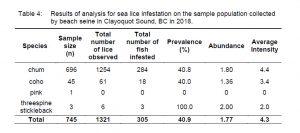
However, the graph in the report that really caught our eye was that showing the spread of lice across all the fish sampled by Mainstream Biological Consulting. This graph shows the number of fish with similar lice counts, rather than an average figure for all the sample.
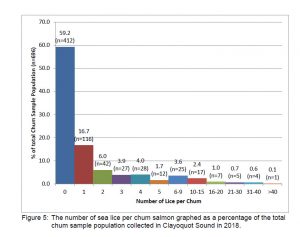
This graph looks extremely familiar to us, at Callander McDowell. In fact, we recently wrote a commentary about sea lice and the way they naturally infest their hosts. We took a graph from Wikipedia showing natural aggregation of metazoan parasites, which includes sea lice,
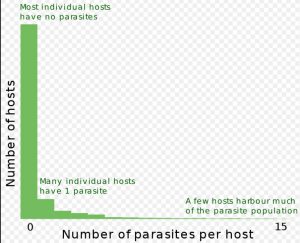
The graph from Cermaq looks incredibly similar to that from Wikipedia. We would suggest that the spread of lice identified by Mainstream Biological Consulting is in line with a natural infestation and is not in any way abnormal.
The problem with this report, like others before it, it assumes that just because the majority of fish caught are infested with sea lice then this sample is representative of the whole population. In fact, it isn’t. As we have previously pointed out, a normal population would have many individuals that have no infestation whereas a few would carry many parasites. The likelihood is that the lice infestation is a secondary issue with the lice attacking fish that are already weakened through poor growth or disease.
Sampling fish in the wild is not an easy task, especially using a seine net. It is surprising how strong healthy fish can evade the net leaving the weak or diseased fish as the sample. It is only necessary to look at the sample sizes of fish caught in Scotland as part of routine monitoring to see the low number of fish that are usually caught.
In the Canadian survey conducted for Cermaq, a total of 690 chum salmon were sampled. However, a total of 7250 chum salmon were caught, from which the sample was retained. We think it is a pity that the surveyors didn’t sample all the fish caught as this would have given an even greater reflection of the state of the stock. By comparison, the research on which the Lousy Choices is based survey just 172 fish. In fact, the researchers sampled 12 sites in total but only managed to catch fish at just four of them. Is this really representative of the wild fish population?
What else was interesting about the report was that all the references to papers about lice infestation were written by Alexandra Morton or her colleagues. The interpretation of these papers is clearly designed to support her claims against the salmon farming industry. Yet, we were recently reminded that her colleague, Martin Krkosek warned that pink salmon populations would be extinct within four generations due to attack by sea lice. However, rather than heading towards extinction, runs of Pink salmon hit record levels.
If salmon farming is responsible for the deaths of wild salmon populations, whether in Canada, Scotland or Norway, then let’s see the evidence rather than this conjecture.
Not just salmon: One of the problems with the anti-salmon farming lobby is that they look on salmon farming in isolation. They see that salmon farms are located near wild salmon rivers and say that these farms are clearly the reason why stocks have declined. However, declines of salmon and sea trout are simply symptomatic of wilder issues affecting the natural world.
The Canadian newspaper, the Global & Mail have reported that caribou, the iconic herbivore, that is even featured on Canadian currency, is on a pathway to extinction in every region where it is currently found. This conclusion follows over a decade of meticulous research aimed at understanding if caribou should be listed as a federal species at risk. Even herds in the most isolated Arctic Tundra are now considered to be threatened, yet 15 years ago, herds were classed as healthy. The Eastern caribou, which once numbered more than a million is now down to about 225,000 animals.
Researchers say that the reason for the fall in numbers is complex, but resource development and climate change are thought to have brought increased pressure to the herds.
We are surprised salmon farming is not blamed for these declines since it seems to be blamed for everything else.
Feed for thought: Fish Farming Expert reported that Skretting intends to cease production of salmon feed in the UK by the end of 2019. The company blames over-capacity in a highly competitive market.
This news comes as no surprise because salmon feed production has an evolving business model and the loss of volume due to increased in house manufacture was predicted long ago. We suspect that Skretting failed to adapt to the changing markets and this latest news is one of the inevitable consequences.
According to the anti-salmon Facebook page, Green MSP John Finnie has said that:
‘It is understood and accepted that the primary reason for these job losses is the opening of Marine Harvest Scotland’s new feed plant on Skye which with Government support has resulted in a potential over-supply of feed to salmon farms in the UK market of 50% and thus rendered the market unviable’.
This may be understood and accepted by John Finnie but we, at Callander McDowell see a very different picture. He is keen to lay the blame at Government’s door for supporting the development of a new mill on Skye, but this will supply just one company’s needs, not just for now, but into the future. There are other salmon farming companies operating in Scotland who will still require to buy feed from the existing sector.
The overall picture is that it is not that there is over-capacity in the feed market, but under-demand from the salmon sector. This under-demand comes from the fact that the development of the salmon industry is met by opposition from Mr Finnie and his colleagues and such opposition has slowed down industry growth. If Mr Finnie is concerned about these job losses, perhaps he should engage with the salmon farming industry and try to understand the various inter-relationships that have led to the current situation. As far as we can gather, the Green’s Environment spokesman has so far refused all invitations to even visit a farm. We would be happy to stand corrected if he has been to see a farm for himself. If he hasn’t, then this is another invitation. However, we know he won’t see this invite because he requested to be removed from our mailing list. We had hoped that anyone who is a politician would be keen to hear both sides of any debate.
Against a background of slower growth than anticipated, some of the feed sector has failed to recognise the need for change. We are afraid that they have just got left behind.

